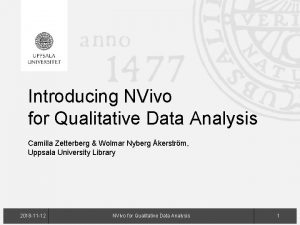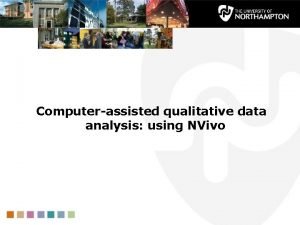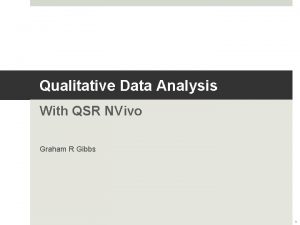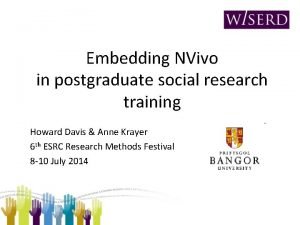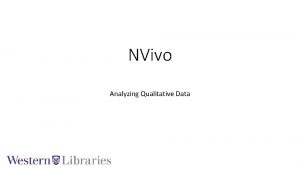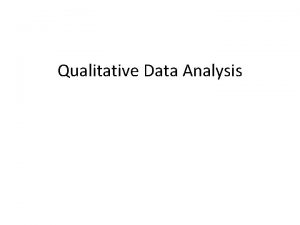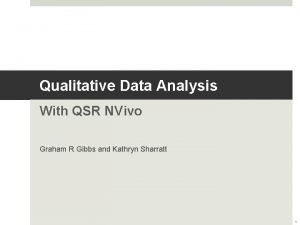Qualitative Data Analysis with NVivo 8 David Palfreyman










- Slides: 10

Qualitative Data Analysis with NVivo 8 David Palfreyman

Outline �Qualitative data and how to analyze it. �Your data �Nvivo 8 2 March 2007 David Palfreyman

Types of qualitative data Interviews Text Focus groups Images Documents Audio Observation Video Artifacts 2 March 2007 David Palfreyman

Research questions �Do teachers in lower- and higher-resourced schools have different attitudes to discipline? May 2009 David Palfreyman

Units of analysis L O T S O F D A T A (in bundles) �Cases �Attributes �Data extracts (e. g. quotations) �Codes (labels) - Relations - Themes 2 March 2007 David Palfreyman M E M O S

MS Word for smaller projects �Search (CTRL+F; Shift+F 4) �Coding with formats (bold, italics, font, size, colour) �Insert comments �Collect quotations (Find formats, copy and paste) 2 March 2007 David Palfreyman

Set up your project in Nvivo �Sources: input data (documents, media files, …); memos. �Nodes: store ideas and coding. �Sets: group your sources and ideas. May 2009 David Palfreyman

Analyze with NVivo � Finding bits of data (e. g. How many informants are over 25? OR: Who mentions “commitment” in their interview? OR: I had a document and some information about Mary – or was it Maria…? – and did I make a note about her? ) � Coding: labelling bits of data (e. g. This person finds ZU students “difficult” –like my previous interviewee) � Queries: asking questions of your data (e. g. How has “commitment” been referred to in the focus groups? OR: Do any of the participants make a connection between “family” and “motivation”? OR: Do men and women tend to differ in their priorities? ) 2 March 2007 David Palfreyman

Seeing (and showing) the bigger picture �Memos: record your thoughts about the data while you remember them! �Models: visualize what is going on in the data. (e. g. concept maps, processes, categories, dimensions) �Links: connect data items and content. �Quantifying codes (e. g. Is there a statistically significant difference between men’s and women’s comments on this issue? ) May 2009 David Palfreyman

Online resources Grounded Theory: A thumbnail sketch http: //www. scu. edu. au/schools/gcm/ar/arp/grounded. html (A clear summary of Grounded Theory as applied to actual data). CAQDAS: A primer http: //www. lboro. ac. uk/research/mmethods/research/software/caqdas_primer. html (a detailed review of various softwares for QDA, comparing their features and also theoretical assumptions they embody). Nvivo 8 tutorials http: //www. qsrinternational. com/support_tutorials. aspx? productid=18 http: //qsrinternational. fileburst. com/Document/NVivo 8/Teach_Yourself_NVivo_8_Tutorials. pdf 2 March 2007 David Palfreyman

